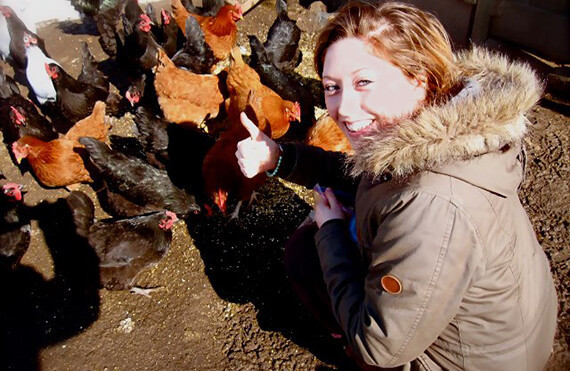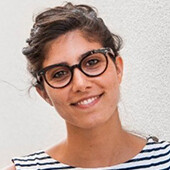Beetles, caterpillars, bees, wasps, ants, grasshoppers, locusts, crickets, cicadas, and termites: These are the most commonly eaten insects in the world. One-third of the world's population (2 billion people) eats them on a daily basis, but when Kathryn Redford, a 29-year-old Canadian entrepreneur, started playing with the idea of feeding Westerners with bugs, she was met with goose bumps and repulsion. They were bugged by bugs, and were not ready to embrace entomophagy—the technical term for eating bugs. This initial defeat forced Redford to rethink her project. Three years later, she is the co-founder of Ofbug, an insect meat producer based in Vancouver, which uses insects in animal feed "to reduce the environmental impact of meat consumption." Keep your minds (and mouths) open. Bugs are here to stay.
IRENE PEDRUELO: Why bugs?
KATHRYN REDFORD: The idea started when I was working at a reptile refuge. A girl who was in charge of the insects to feed the reptiles was really knowledgeable about their nutritional profiles. I had heard about bugs being used to feed pets, but their nutritional value and low impact was something I had never thought about before. That is as far as I went with it, I just thought about it. A couple of years later, I was in Connecticut because my husband was at business school. We were seeing all these people starting businesses, and I thought: If I am going to do it, this is probably an optimal time to do it. I started out with the idea of making an insect product for humans. I did some surveys and 90 percent of the people interviewed said that they liked the concept, but they did not like the idea of eating bugs.
IRENE PEDRUELO: So you came up against a wall, which was not very rational—Westerners find bugs repulsive, for no particular reason. So what did you do?
KATHRYN REDFORD: I ruled out that idea. I soon realized that if an insect product was used for reptiles, it could also be used to feed other animals. I did not have much knowledge about the breeding industry except that they use natural ingredients in animals' diets. I started breeding silkworms, crickets, mealworms, worms, and superworms, just to see which one would breed the easiest. I hadn't envisioned breeding all of them for too long, but I didn't know which one to start with. I quickly nailed it down to mealworms because they seemed the cleanest and the easiest, and they grew relatively fast. That was 2011.
IRENE PEDRUELO: Where was all this happening?
KATHRYN REDFORD: Oh! In my apartment. I was living with my partner in a one-bedroom apartment. He's used to my obsession with animals, and me having weird ideas. So this wasn't super far-fetched. He didn't have a huge problem.
IRENE PEDRUELO: Once you discovered which bugs were the best for breeding, what was the next step?
KATHRYN REDFORD: I tried to find someone who would use bugs in their feed. It actually was not as hard as I thought it would be, because there were a lot of young people starting new farms, who were part of the green movement. I found a farmer named Nicki. She had started a poultry farm, which was less than 50 chickens at the time, and some goats and ducks. She was trying to find a soy-free alternative.
IRENE PEDRUELO: And that is how the trial period started.
KATHRYN REDFORD: Soy and fish-meal are currently the main components in livestock feed. Nicki was trying to find something that was cost-competitive with soy or corn, which is almost impossible. I figured I could do a couple of free trials with her, to get the project to the next step.
IRENE PEDRUELO: Did the chickens like your home-bred bugs?
KATHRYN REDFORD: The chickens would devour the bugs, and after that half-heartedly eat their own feed. To get that trial up and going, and then a second trial, we had been breeding bugs a year and a half. I made between 5 and 7 pounds, which is what we used.
IRENE PEDRUELO: According to Greenpeace, 80 percent of soya worldwide is used to feed cattle. The growing demand for meat is triggering an ongoing expansion of soy agriculture, and this is coming hand in hand with increasing levels of deforestation in places like Amazonia. Is producing breeding insects less energy intensive and better for the environment?
KATHRYN REDFORD: According to the FAO (Food and Agriculture Organization of the United Nations), livestock accounts for 70 percent of all agricultural land use. I could throw a lot of scary numbers out there for you, but I think these numbers are lost on people because they're just too big to wrap your head around. It's hard to understand what they mean exactly. That 70 percent includes the land used to grow the crops we feed our farmed animals with. These feed crops use unimaginable amounts of our accessible fresh water. They also need fertilizers because we grow crops—namely soy—as a crop monoculture. If you think about what that means, it's insanity. We use so many fertilizers on our feed crops that we're altering the natural nitrogen cycle of our planet. Producing food this way takes on the mentality, "That's how we've always done it;" and I hate that mentality.
IRENE PEDRUELO: So how are insects more energy efficient?
KATHRYN REDFORD: Insects are one solution to a very complicated issue. We can control the amount of water they need with humidity. They need for very little. We can grow them vertically, and they're healthyen masse and in small spaces, so they don't need a lot of space. They produce waste of course, but their waste is nutrient-dense and can be sold to farmers and gardeners. Speaking of waste, that's what we feed them with. We divert pre-consumer food waste that would otherwise be headed to the landfill, we put it right back into the food system safely. Insects are reared on a closed-loop system. Yes, we dehydrate our insects, so we do use energy that way; but unlike crops, we do not require fuels to run any tractors or heavy machines and we do not require huge processing systems. We obviously don't need pesticides and fertilizers or antibiotics. The inputs for insects are cleaner and simpler.
IRENE PEDRUELO: In addition to funding, are you encountering additional obstacles?
KATHRYN REDFORD: It is such a new industry. Right now we are trying to improve our breeding procedure and trying to get everything just really right on the micro-scale before we expand into the commercial. We are not in any huge rush, because insects have not been accepted as a feeding ingredient here in Canada yet.
IRENE PEDRUELO: What does that mean?
KATHRYN REDFORD: It means that if we do sell to the farmers, those farmers cannot sell the product to farmers' markets, grocery stores, etc. As long as their product is meant for human consumption it cannot be fed with bugs. So right now we are very much a research company. We are doing a lot of trials. The chemical analysis stage is still a couple of months away. A lot of research needs to be done prior to being accepted as a feeding ingredient, which is what we are trying to do.
IRENE PEDRUELO: How do you envision your business growing? Will growth come together with a change in the law?
KATHRYN REDFORD: There is a huge movement towards a more sustainable farming for a reason: people want it, they care, and there is a lot of information out there that was not available before. The CFIA (Canadian Food Inspection Agency) is looking into making insects viable as a feed ingredient. These laws being passed is an inevitability, especially as insects become cheaper and farmers' demand increases. But these processes take longer than people expect. What bothers me about feeding ingredients right now is how unnatural they are for the animal. That is why they have to add all the antibiotics, because it is an unhealthy diet.
IRENE PEDRUELO: Until the law is changed, should we just content ourselves and assume we won't be able to eat meat labelled "insect-fed"?
KATHRYN REDFORD: If we can supply that demand the industry will grow, but right now we are stuck at the supply phase.
IRENE PEDRUELO: Do you think you are stuck partly because soy production is subsidized?
KATHRYN REDFORD: Yes. We have to be cost-competitive. I don't want to overcharge farmers, but we are a business at the end of the day, we have to make money. If soy wasn't subsidized we probably would be cost-competitive. Money not only goes to crops and transporting the soy, but also to processing the soy so that it's in a form that can be digested by a chicken in the first place. That is a very costly and lengthy process, and I can't imagine soy being the price it is if it wasn't subsidized. Soy is a huge cloud over all agriculture.
IRENE PEDRUELO: Wouldn't it be easier to change what we think about insects so we eat them directly in the first place?
KATHRYN REDFORD: I stopped thinking about insects as for human consumption because I thought that the psychological barrier would be way too hard to overcome; but that was two years ago, and I have seen a big change. Now there are a lot of companies out there that are doing insects for human consumption. It is weird, and people like that. I hope it doesn't die out as a trend, and hopefully the product will stand for itself. As soon as people start realizing the impact it could have and the fact that it is very nutritious . . . the real hold will begin.
Policy Innovations' Five Quick Questions
What does social innovation mean to you?
It's everybody banding together to create something for each other, for everybody.
What are the three main attributes of a social innovator?
Opinionated, able to do things for the greater good even if the benefits don't happen in your lifetime, and competitive even if it is with a giant.
Where do you see yourself in 20 years?
I hope to be doing this for the near future and I hope at least it becomes a source of education for people. I would love to be doing anything that has to do with either consulting with farmers who need more sustainable feed, or being a bug breeder, or anything in between.
What other obsessions do you have?
Other than animals? I don't know I can say I feel as passionately about anything else as I do about nature.
What would you tell your younger self if you had to start over?
I would tell myself to be flexible, don't take criticisms too harshly, don't be so affected by what other people say who don't understand about the business, and be open to being wrong.
(This interview was edited for clarity.)





